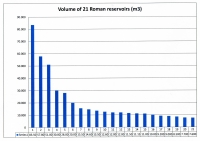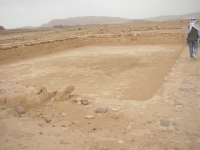Largest Roman Reservoirs
There is a difference between cisterns and reservoirs: cisterns are commonly subterranean, rock cut, without a particular inlet or outlet, apart from a kind of well-top plus cover. Its main purpose is to store rain water. Reservoirs are often larger, sub- or superterranean, masonry built, and mainly used to store aqueduct water, and equipped with an inlet and one or more outlet(s).In some Roman towns - like in Pompeii (Italy) for instance - many houses were equipped with a cistern under the impluvium to store rain water. After the town got an aqueduct, the cistern was also connected to the aqueduct.
The biggest reservoirs were related to baths buildings especially in Rome (Baths of Diocletian and Caracalla) and in (North) Africa. To feed the biggest reservoirs in Rome, special adaptations were necessary to the extant aqueduct lines.
The major reservoirs of Constantinople, all built after 400 AD, were uncovered and comparable to lakes behind artificial dams. In late antiquity Constantinople was also equipped with many not less impressive, subterranean reservoirs like the Bindirdirek reservoir 'with the thousand and one columns'.
The next group of huge reservoirs were all in North Africa and some in the present Middle East. The famous Piscina Mirabilis is the largest one in present Italy.
Note: As indicated below, often there is some discussion about the capacities of these reservoirs. Some scholars indicate its maximum volume, others give a modest figure for reservoirs were seldom used to its maximum capacity.
| Location / name | Volume (m3) | Literature | Remarks |
|---|---|---|---|
| Constatinople, Mokios (Turkey) | 237.000 | Crow 2008 acc to Cecen; Wilson 2008: 250.000m3 | not covered; 500 AD |
| Constatinople, Aetius (Turkey) | 197.000 | Crow 2008 acc to Cecen; Wilson 2008: 300.000m3 | not covered; 412 AD |
| Constatinople, Aspar (Turkey) | 173.000 | Crow 2008 acc to Cecen; Wilson 2008: 230.000m3 | not covered; 459 AD |
| Constantinople, Yerebatan (Turkey) | 83.500 | Wilson 2008; Doring 2007c: 80.000m3 | covered |
| Constantinople, Bindirdirek (Turkey) | 57.800 | Wilson 2008 | covered; 224 pilars (Crown 2008) |
| Carthage, La Malga (Tunisia) | 51.000 | Wilson 2008; Wilson 1998 based on Verite 1989; Wilson 1997: 56.500 - 73.500 m3 | linked to the Antonine baths |
| Cirta (Algeria) | 30.000 | Wilson 1997; Wilson 1998 based on Gsell 1901 | linked to a baths ? |
| Zama (Tunisia) | 28.000 | Wilson 1997; Wilson 1998 based on Drapier 1899 | linked to a baths? |
| Carthage, Bordj Djedid (Tunisia) | 20.000 | Wilson 1997, 1998, 2008; Tolle 1990 and Doring 2007c: 30.000m3 | associated with Antonine baths |
| Capitolias / Beit Ras (Israel) | 15.500 | Kamash 2006 | not covered (!) |
| Sergiopolis/Resafa (Syria) | 14.600 | Kamash 2006 | |
| Thapsus (Algeria) | 13.500 | Wilson 1997 | |
| Misenum, Piscina Mirabilis (Italy) | 12.600 | Wilson 2008, Wilson 1998 based on Tolle 1990; Doring 2007c: 10.700m3 | Water storage for the Roman fleet; no exit |
| Tubusuptu (Algeria) | over 12.000 | Wilson 1997 | |
| Hippo Regius (Algeria) | 12.000 | Wilson 1997 | |
| Rome, Baths of Caracalla | 11.500 | Wilson 2008, Wilson 1998 based on Manderscheid & Garbrecht 1994; Tolle 1990 made a mistake with 80.000 m3; Yegul1992 refers to 40.000 m3 | Fed by the Aqua Antoniniana / Aqua Marcia |
| Utica (Tunisia) | 11.150 | Wilson 1997 | |
| Thapsus/Rusicade (Algeria) | 11.000 | Wilson 1997 | Beni Melek 2 |
| Latium, Albano, 'Cisterone' (Italy) | 10.000 | Doring 2007c | |
| Simitthus (Tunisia) | 9.200 | Wilson 1997 | |
| Thapsus / Rusicade (Algeria) | 9.000 | Wilson 1997 | Beni Melek 1 |
| Thugga/Dougga, Ain Mizeb (Tunisia) | 8.500 | Wilson 1997; Tolle 1990: 15.000 m3 from Ain el Hammam; de Vos Raaijmakers: 6.000 m3 | Baths of the Cyclops or the Licinian Baths? |
| Misenum (Italy), Grotta Dragonara | 7.700 | Doring 2007c | not fed by an aqueduct |
| Bararus (Tunisia) | 7.600 | Wilson 1997 | |
| Rome, Sette Sale | 7.000 | Wilson 2008; Tolle 1980 made a mistake with 10.000m3 | related to the Baths of Traian |
| Carthage (Tunisia) | 7.000 | Wilson 1997 | Turris Aquaria |
| Rome, Botte di Termini | 6.600 | Wilson 2007 based on Ligorio as cited by Lanciani 1881 | related to the Baths of Diocletian |
| Baia, High Basin (Italy) | 6.000 | Doring 2007c | not fed by an aqueduct |
| Sepphoris (Israel) | 4.300 | Tsuk 1999 | built in a cave |
| Piscina Cardito (Italy) | 4.120 | Doring 2007c | |
| Salamis (Cyprus) | 4.000 | Own observation | also called Loutron |
| Puteoli, Cento Caramelle II (Italy) | 2.960 | Doring 2007c | high + low; not aqueduct fed |
| Puteoli, Piscina Lusciano (Italy) | 2.800 | Doring 2007c | |
| Crypta Romana (Italy) | 2.050 | Doring 2007c |
Wilson2008 suggested Chieti (still missing) and Aptera on Crete (2 reservoirs of each 3250 m3
based on sanders1982 who also suggested the two reservoirs at Eleutherna, each 5500 m3)
| HOME | Literature references | Last modified: January, 2012 by w.d.schram 'at' romanaqueducts.info |



